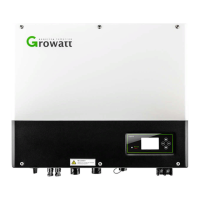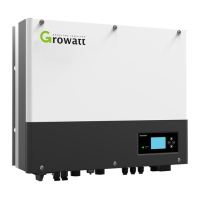Do you have a question about the Growatt SPH-UP Series and is the answer not in the manual?
Manual provides users with detailed product information and installation instructions.
Identifies qualified electrical personnel as installers and outlines inverter compatibility with battery types.
Explains SPH Series use for storing energy and powering loads, including backup power.
Provides crucial safety guidelines for installation and operation to prevent hazards and voiding warranty.
Illustrates the system chart of SPH, showing PV array, hybrid inverter, battery, and grid connections.
Details safety warnings for high voltage, hot surfaces, radiation, and the importance of proper grounding.
Explains common safety symbols used on the SPH inverter, such as electrical shock, hot surface, and danger.
Lists the six types of SPH series inverters available, such as SPH 3000 TL BL-UP.
Details the labels and specifications found on the SPH inverter, including input/output data and battery info.
Provides the physical dimensions (A, B, C) and weight (27kg) of the SPH TL BL-UP inverter.
Highlights features like self-use function enhancement, smart management, easy installation, and dual MPP trackers.
Details location suitability, dimensions, material compatibility, ingress protection, battery proximity, ambient temperature, and mounting orientation.
Lists necessary tools for installation and explains the LAN line RJ45 sequence and wiring color codes.
Provides step-by-step instructions for installing the SPH inverter, including drilling and mounting.
Discusses sensor cable length considerations (wired sensor ≤15m, meter ≤100m) for attention layout.
Outlines the process for mounting the SPH inverter on a wall, including drilling, bolt insertion, and securing.
Explains the system connection modes for SPH inverters, covering DC and AC connections.
Specifies solar module requirements, connector types, MPPT input limits, and caution for DC input voltage.
Warns about lethal voltages and details safe procedures for connecting the PV array, including voltage limits.
Describes connecting the AC grid terminal for grid-connected operation and the EPS output terminal for critical loads.
Provides step-by-step instructions for connecting the battery terminals, including cable gland and polarity.
Details the steps for connecting the current transformer (CT) terminal for monitoring power consumption.
Explains how to connect the meter terminal for monitoring energy flow, using RJ45 network cable.
Guides the connection of CAN communication terminal for lithium batteries, using RJ45 plug.
Provides steps for connecting RS485 communication terminal for lithium batteries to the BMS system.
Details the connection of the DRMS terminal, specifically for Australia, using RJ45 plug.
Explains how to connect the NTC temperature probe for lead-acid batteries to monitor ambient temperature.
Outlines the wiring steps for the dry contact to communicate with external devices like water heaters.
Details the grounding connection requirements, including point location and minimum cable diameter.
Lists the sequential steps for electrifying and commissioning the SPH inverter after installation is complete.
Describes the different operational modes of the SPH inverter, including Normal, Fault, Programming, Checking, Standby, and Shutdown.
Explains Normal mode including Online and Backup modes, and priority settings like Load First, Battery First, Grid First.
Details the Fault mode where the inverter monitors and displays system or machine faults, indicated by the LCD and LED.
Identifies various sections of the LCD display, such as State, Information, PV input, Grid, Battery SOC, and Local Load.
Explains the status indications of the LED (green/red) and the functions of the ESC, Down, Enter, and UP buttons.
Describes the LCD display column, noting that it shows country-specific rules and regulations for machine configuration.
Guides users through setting up various work modes via the inverter's interface, including Basic Parameter, Priority, and Export Limit.
Explains that the USB port is primarily for firmware updates and system monitoring, not for charging.
Describes monitoring solutions via Growatt's Shine server or Shine phone app using Wi-Fi-X/Shine Link-X collectors.
Details the method for setting national security standards using buttons to toggle display and confirm settings.
Presents a table mapping country/region regulations to specific model display codes for inverter configuration.
Outlines regional power grid settings for compliance with AS/NZS 4777.2:2015, including Volt-Watt and Volt-Var settings.
Describes checking firmware version, region, country, and power quality response modes through the interface.
Provides sequential steps for starting up the SPH inverter, including connecting PV, Grid, Battery, and turning on switches.
Details the procedure for safely shutting down the SPH system by turning off breakers, disconnecting cables, and waiting for indicators to go out.
Guides users on troubleshooting SPH inverter faults by providing necessary information to Growatt support and referencing online Q&A.
Lists common error messages and their descriptions, along with suggested troubleshooting steps for resolving inverter faults.
Provides instructions for safely dismantling the SPH inverter, including disconnection, cable removal, and heat precautions.
Advises on packaging SPH inverters using original boxes or suitable cartons, handling with care during transport.
Recommends storing the SPH inverter in a dry environment with ambient temperatures between -25°C and +60°C.
Instructs to dispose of the SPH inverter according to electronic waste regulations, not with household waste.
Presents a detailed specification table for SPH series inverters, covering DC input, AC output, and battery data.
Provides specifications for MC4 connectors used for DC input, including current rating and voltage.
Specifies torque values for upper cover screws, DC connector, M6 screwdriver, and grounding screw.
Lists optional appendix items like Shine Link-X, Shine Wi-Fi-X, and SPM sensors with their GROWATT P/N.
Manual provides users with detailed product information and installation instructions.
Identifies qualified electrical personnel as installers and outlines inverter compatibility with battery types.
Explains SPH Series use for storing energy and powering loads, including backup power.
Provides crucial safety guidelines for installation and operation to prevent hazards and voiding warranty.
Illustrates the system chart of SPH, showing PV array, hybrid inverter, battery, and grid connections.
Details safety warnings for high voltage, hot surfaces, radiation, and the importance of proper grounding.
Explains common safety symbols used on the SPH inverter, such as electrical shock, hot surface, and danger.
Lists the six types of SPH series inverters available, such as SPH 3000 TL BL-UP.
Details the labels and specifications found on the SPH inverter, including input/output data and battery info.
Provides the physical dimensions (A, B, C) and weight (27kg) of the SPH TL BL-UP inverter.
Highlights features like self-use function enhancement, smart management, easy installation, and dual MPP trackers.
Details location suitability, dimensions, material compatibility, ingress protection, battery proximity, ambient temperature, and mounting orientation.
Lists necessary tools for installation and explains the LAN line RJ45 sequence and wiring color codes.
Provides step-by-step instructions for installing the SPH inverter, including drilling and mounting.
Discusses sensor cable length considerations (wired sensor ≤15m, meter ≤100m) for attention layout.
Outlines the process for mounting the SPH inverter on a wall, including drilling, bolt insertion, and securing.
Explains the system connection modes for SPH inverters, covering DC and AC connections.
Specifies solar module requirements, connector types, MPPT input limits, and caution for DC input voltage.
Warns about lethal voltages and details safe procedures for connecting the PV array, including voltage limits.
Describes connecting the AC grid terminal for grid-connected operation and the EPS output terminal for critical loads.
Provides step-by-step instructions for connecting the battery terminals, including cable gland and polarity.
Details the steps for connecting the current transformer (CT) terminal for monitoring power consumption.
Explains how to connect the meter terminal for monitoring energy flow, using RJ45 network cable.
Guides the connection of CAN communication terminal for lithium batteries, using RJ45 plug.
Provides steps for connecting RS485 communication terminal for lithium batteries to the BMS system.
Details the connection of the DRMS terminal, specifically for Australia, using RJ45 plug.
Explains how to connect the NTC temperature probe for lead-acid batteries to monitor ambient temperature.
Outlines the wiring steps for the dry contact to communicate with external devices like water heaters.
Details the grounding connection requirements, including point location and minimum cable diameter.
Lists the sequential steps for electrifying and commissioning the SPH inverter after installation is complete.
Describes the different operational modes of the SPH inverter, including Normal, Fault, Programming, Checking, Standby, and Shutdown.
Explains Normal mode including Online and Backup modes, and priority settings like Load First, Battery First, Grid First.
Details the Fault mode where the inverter monitors and displays system or machine faults, indicated by the LCD and LED.
Identifies various sections of the LCD display, such as State, Information, PV input, Grid, Battery SOC, and Local Load.
Explains the status indications of the LED (green/red) and the functions of the ESC, Down, Enter, and UP buttons.
Describes the LCD display column, noting that it shows country-specific rules and regulations for machine configuration.
Guides users through setting up various work modes via the inverter's interface, including Basic Parameter, Priority, and Export Limit.
Explains that the USB port is primarily for firmware updates and system monitoring, not for charging.
Describes monitoring solutions via Growatt's Shine server or Shine phone app using Wi-Fi-X/Shine Link-X collectors.
Details the method for setting national security standards using buttons to toggle display and confirm settings.
Presents a table mapping country/region regulations to specific model display codes for inverter configuration.
Outlines regional power grid settings for compliance with AS/NZS 4777.2:2015, including Volt-Watt and Volt-Var settings.
Describes checking firmware version, region, country, and power quality response modes through the interface.
Provides sequential steps for starting up the SPH inverter, including connecting PV, Grid, Battery, and turning on switches.
Details the procedure for safely shutting down the SPH system by turning off breakers, disconnecting cables, and waiting for indicators to go out.
Guides users on troubleshooting SPH inverter faults by providing necessary information to Growatt support and referencing online Q&A.
Lists common error messages and their descriptions, along with suggested troubleshooting steps for resolving inverter faults.
Provides instructions for safely dismantling the SPH inverter, including disconnection, cable removal, and heat precautions.
Advises on packaging SPH inverters using original boxes or suitable cartons, handling with care during transport.
Recommends storing the SPH inverter in a dry environment with ambient temperatures between -25°C and +60°C.
Instructs to dispose of the SPH inverter according to electronic waste regulations, not with household waste.
Presents a detailed specification table for SPH series inverters, covering DC input, AC output, and battery data.
Provides specifications for MC4 connectors used for DC input, including current rating and voltage.
Specifies torque values for upper cover screws, DC connector, M6 screwdriver, and grounding screw.
Lists optional appendix items like Shine Link-X, Shine Wi-Fi-X, and SPM sensors with their GROWATT P/N.
| Type | Hybrid Inverter |
|---|---|
| Protection Rating | IP65 |
| Number of MPPTs | 2 |
| AC Voltage Range | 180-280V |
| THDi | <3% |
| AC Grid Frequency | 50/60Hz |
| Communication Interfaces | Wi-Fi, RS485, USB |
| Nominal AC Voltage | 230 V |
| Operating Temperature Range | -25°C to +60°C |
| Cooling Method | Natural Cooling |












